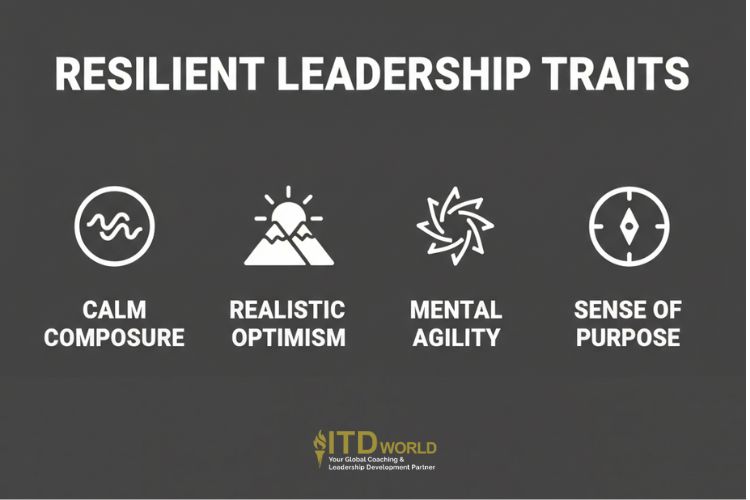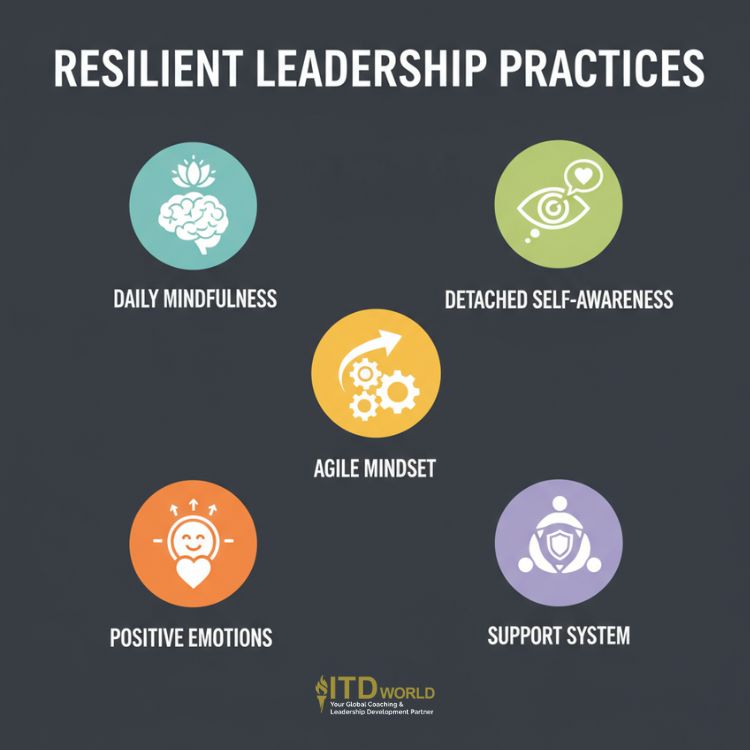A practical framework for building resilient leadership and becoming the source of strength the team needs when it matters most.
Leadership is easy when the seas are calm. The true measure of a leader, however, is not found in times of stability, but in how they function during a crisis. It is in these moments of pressure, uncertainty, and high stakes that resilient leadership emerges as the single most important capability.
|
Author: Jonathan M. Pham |
Highlights
- Resilient leadership is the ability to anticipate, prepare for, respond to, and adapt to change and disruption, enabling leaders to guide their teams through adversity, learn from challenges, and emerge stronger and more effective than before. It is a crucial requirement for navigating constant disruption, mitigating employee burnout, and driving performance while retaining top talent in today’s volatile and complex world.
- The 5Fs Framework (Focus, Fast, Flexible, Fearless, and Fun) provides a practical, holistic system for leaders to cultivate sustainable resilience by guiding their mindset and actions to navigate adversity with clarity, speed, agility, courage, and energy.
- To cultivate resilience, leaders should intentionally adopt practices such as mindfulness, detached self-awareness, having an agile and experimental mindset, cultivating positive emotions like gratitude, and building a strong personal support system. For organizations, they should invest in targeted training and coaching, foster psychological safety, provide developmental challenges with supportive resources, and establish mechanisms such as EAPs and peer advisory groups.
- Contrary to common myths, leadership resilience is a dynamic, learnable skill set involving emotional regulation, not an innate or emotionless trait; it requires leaders to learn to manage their own well-being and address team resistance to change through empathy and transparency.
What is Resilient Leadership?
Resilient leadership is the ability for leaders to anticipate, prepare for, respond to, and adapt to both incremental change and sudden disruptions. It is an active, dynamic, and learnable skill set that allows one to guide their teams through adversity and emerge stronger on the other side.
Traditionally, resilience is perceived as the ability to bounce back to one’s original state after a setback. However, that is not enough in today’s business landscape. A resilient leader doesn’t just weather the storm; they learn from it, harnessing the experience to become more capable, insightful, and effective than before. In other words, they “bounce forward”.
Key characteristics of resilient leaders:
- Calm composure: The ability to regulate one’s own emotions and project a sense of stability and confidence, even when personally feeling stressed. It prevents the leader’s anxiety from becoming the team’s anxiety.
- Realistic optimism: Acknowledging a situation’s harsh reality without sugar-coating it, while simultaneously maintaining a steadfast belief in the team’s ability to overcome the challenge.
- Mental agility and flexibility: The capacity to let go of a failing plan, consider a wide array of perspectives, and pivot quickly to a different approach as soon as circumstances change.
- A strong sense of purpose: Being anchored by a clear “Why” that provides meaning and motivation during turbulent times.

Examples of Resilient Leaders
The above-mentioned combination of traits has been demonstrated by some of the most respected leaders in history and business.
- A historical example: Nelson Mandela. His ability to endure 27 years of imprisonment and emerge without bitterness, ready to lead South Africa toward reconciliation, is a testament to personal resilience. Thanks to his unwavering vision – a free and equal nation – and calm composure, Mandela was able to withstand unimaginable adversity and guide his country through a fragile transformation.
- A business example: Satya Nadella. When Nadella became CEO of Microsoft in 2014, the company was widely seen as having missed key market shifts. And yet, Nadella demonstrated remarkable mental flexibility by leading a massive cultural pivot from a “know-it-all” to a “learn-it-all” mindset. He steered the company’s strategy towards cloud computing and open-source collaboration – areas Microsoft had previously resisted -showing the ability to adapt and bounce the entire organization forward into a new era of success.
The Importance of Resilience in Leadership
The current work environment is defined by a level of volatility and complexity that makes resilient leadership a necessity for survival and growth.
- Navigating constant disruption: The relentless pace of AI-driven transformation, coupled with economic uncertainty and geopolitical instability, means that change is now a constant state. Only resilient leaders can provide the stable, clear-headed decision-making required to guide their teams through this turbulence without becoming paralyzed.
- Countering the employee burnout epidemic: The pressures of the modern workplace have taken a significant toll on employees, with reports consistently showing that employee stress is at a record high. A leader’s personal resilience acts as a critical buffer for their team. In fact, research has demonstrated a direct link between a leader’s positive behaviors and their people’s well-being.
- Driving performance & retaining talent: Studies have concluded that teams led by resilient leaders are typically more engaged, innovative, and better able to maintain performance during challenging periods. Furthermore, in today’s competitive talent market, a leader who provides stability and support is a key reason why top performers choose to stay.

Leadership resilience in a digital age
Conversely, the presence of a “brittle” leader who is easily overwhelmed or reactive brings about tangible and destructive consequences. Not only does their contagious anxiety creates chaos, but they are also more likely to make impulsive, short-sighted decisions or become paralyzed by indecision, stalling progress when action is most needed. Under their management, people are more likely to suffer from burnout and leave the organization, resulting in costly talent drain.
In today’s world, investing in leadership resilience is no longer just about developing leaders; it’s about future-proofing the entire organization.
Elements in Resilient Leadership: The 5Fs Framework
To cultivate resilienc sustainably, leaders need more than just a vague intention to be “stronger”; they need a practical and memorable framework to guide their mindset and actions. At ITD World, our approach is built upon the 5Fs of Leadership Resilience, developed by Dr. Peter Chee, Dr. William J. Rothwell, and Aaron Ngui. The model provides a holistic system that addresses the clarity, speed, agility, courage, and energy required to lead through any form of adversity.
-
Focus
In the midst of chaos, the ability to focus is paramount. This means cutting through the noise to prioritize the few high-impact tasks and projects that will deliver the most significant results. For teams, it involves the leader’s ability to consistently align everyone’s energy with the organization’s purpose, values, and vision, providing a clear “North Star” when everything else is in motion.
In practice: A focused leader, amidst market turmoil, will communicate to their team: “There are a hundred things we could do right now, but for this quarter, we will concentrate exclusively on retaining our top 20 clients. That is our single most important goal.”
-
Fast
In a rapidly changing environment, speed of adaptation is a key advantage. Essentially, it’s about emphasizing effective action and rapid iteration over slow, perfect planning. It encourages leaders and their teams to test ideas, learn quickly, and pivot away from what doesn’t work while maintaining a standard of excellence.
In practice: Rather than spending six months building a “perfect” product in isolation, one would advocate developing and launching a “minimum viable” prototype to get real-world feedback quickly,
Read more: Change Management – Best Practices for Leading Organizational Transformation
-
Flexible
Flexibility is the mental agility to find alternative solutions when initial plans inevitably falter. It is the ability to let go of a preconceived path, embrace new information, and creatively adjust the approach to stay on track toward the main goal.
In practice: When a key supplier suddenly fails, a flexible leader doesn’t just look at the problem; they see a new set of options. They facilitate a brainstorm asking, “Okay, Plan A is no longer possible. What could Plan B, C, or D look like? How can we turn this situation into an opportunity to establish a stronger supply chain?”
-
Fearless
Rather than recklessness or an absence of fear, fearlessness means being well-equipped with the courage and personal energy to face challenges head-on. Such inner strength is supported by maintaining high energy levels, boosting self-esteem, providing mentorship, and inspiring belief in the collective mission.
In practice: A leader should be willing to make a difficult but necessary decision – such as decommissioning a popular but unprofitable legacy product – because they have the conviction that it is the right choice for the long-term health of the organization.
-
Fun
Even in the most challenging times, maintaining a positive outlook and fostering authentic human connection provides a powerful tool for bouncing forward. This involves the intentional practice of generating hope, celebrating small wins, and finding moments of lightness to replenish the team’s emotional reserves.
In practice: A leader infuses fun and positivity by starting a tense meeting with a moment of genuine appreciation for the team’s hard work, by using appropriate humor to break the tension, or by scheduling a simple team lunch to reconnect on a human level after a hardworking week.

What makes a resilient leader
Practices for More Resilient Leadership
Understanding the 5F framework is the first step; the real value comes from intentionally adopting the following five practices:
-
Master your attention through mindfulness
The foundation for building Focus, mindfulness involves training your mind to be fully present and to consciously choose where you direct your energy, rather than being pulled in multiple directions by distractions.
It is recommended that you start your day with a five-minute meditation or a simple breathing exercise. Over time, it will strengthen your ability to resist distractions, maintain clarity on your highest priorities, and approach every day with intention instead of reactivity.
Read more: Uplifting Meditation Technique
-
Practice detached self-awareness
The ability to observe your own thoughts and feelings (especially fear and anxiety) without being swayed by them is a core component of Emotional Intelligence – and is crucial for being Flexible and Fearless. When you feel a strong negative emotion like frustration or panic, try pausing and mentally naming it: “This is a feeling of anxiety.” As simple as it may seem, neuroscience research has found out that such an act of observation creates a space between the feeling and your reaction, allowing you to come up with a more deliberate and thoughtful response.
Read more: Thoughtful Leadership – Why It Matters in Today’s Hectic World
-
Embrace an agile, experimental mindset
This is the key practice for becoming both Fast and Flexible. It involves letting go of the need for perfection and instead prioritizing rapid learning and iteration. For instance, instead of aiming for a perfect, large-scale plan, ask your team, “What is the smallest, fastest experiment we can run this week to test our assumption?” Doing so reduces the fear of failure and builds momentum through quick, small wins, enabling you to adapt based on real-world data.
-
Intentionally cultivate positive emotions
The idea here is to proactively generate the positive emotions that act as a buffer against stress and burnout. Consider making gratitude journaling a regular habit. At the end of each day, write down three specific things that went well, no matter how small. Over time, your brain will gradually be trained to scan for positives, which builds realistic optimism and enhances your overall well-being.
-
Build your personal support system
Resilience is not about being a lone hero; it is about knowing when and how to draw strength from others. This is essential for maintaining a Fearless outlook over the long term. As such, it is vital that you intentionally cultivate a network of trusted peers, mentors, and potentially an executive coach. Having a confidential space to process challenges, gain exposure to new perspectives, and share vulnerabilities is one of the most powerful resources a leader can have for sustaining their energy.

Agile resilient leadership
How Organizations May Build More Resilient Leaders
- Invest in targeted training and coaching
Resilience is a teachable skill set. As such, organizations should provide formal training focused on the specific qualities needed to lead through adversity (e.g. stress management, emotional regulation, leading through change, etc.). Furthermore, offering one-on-one executive coaching gives leaders a confidential and personalized space to work through their unique pressures and come up with bespoke resilience strategies.
- Foster psychological safety
For leaders to be able to create a safe environment for their teams, they must first feel psychologically safe with their own peers and superiors. Therefore, senior executives must model vulnerability. A culture where a Vice President can openly say in a leadership meeting, “My team is feeling the pressure on this project, and I’m struggling with how to best keep them motivated,” is one where leaders can support each other and solve problems collaboratively, rather than projecting an image of perfection while suffering in silence.
Read more: Leading by Example – Key to Truly Inspiring Action & Trust
- Provide “developmental challenges” with support
Resilience, like a muscle, is best built through resistance. Organizations can create controlled, high-stakes experiences that strengthen their management team’s capabilities.
In practice: Give high-potential leaders “stretch” assignments – carefully selected, challenging projects that push them out of their comfort zone. For example, one may be asked to turn around a struggling team or to lead a high-pressure, time-sensitive initiative.
Crucially, these challenges must be paired with strong support, such as a dedicated mentor and regular check-ins, to ensure the experience is a productive learning opportunity and not a “sink-or-swim” test.
- Establish robust support systems
Because leaders absorb so much organizational stress, they require dedicated support systems to maintain their own well-being and effectiveness. In other words, they need to have easy and confidential access to mental health resources through Employee Assistance Programs (EAPs) and dedicated coaching.
Another strategy is to create peer advisory groups, where a small cohort of leaders meet regularly to share challenges and advice in a confidential setting. This prevents the isolation that typically leads to leadership burnout.
Read more: Resilience in the Workplace – Thriving in the Era of Crises
Common Misconceptions About Leadership Resilience
- “Resilience is a fixed trait”
The myth: A common belief is that people are either “born resilient” or they are not – that it is an innate, unchangeable personality trait.
The truth: While some individuals may demonstrate a more naturally resilient disposition, modern psychology and leadership research have clearly shown that resilience is a dynamic capability. It is comprised of specific mindsets and skills – such as emotional regulation, cognitive flexibility, and optimism – that can be intentionally cultivated through conscious practice, training, and coaching.
- “Resilient leaders are emotionless and unbreakable”
The myth: This is the dangerous stereotype of the resilient leader as a stoic, unflappable “rock” who never shows vulnerability or expresses negativity. It is a major cause of what can be called “toxic resilience” – an unhealthy cultural expectation that leaders and their teams should silently endure immense pressure, excessive workloads, or even a poor work environment.
The truth: It is not about being devoid of emotion, but about emotional regulation. Resilient leaders feel the same stress, frustration, and disappointment as anyone else. However, they have developed the capacity to acknowledge these feelings without succumbing to them – so that they can think clearly and act deliberately under pressure. Additionally, when facing a broken system, they are courageous enough to speak up and find the tools to fix it.
Example: After a major setback, one may say, “This is a tough blow, and it’s okay for us to be disappointed today. Let’s take the time we need to process this. Tomorrow, we will regroup and focus all our energy on our path forward.”

Challenges of Resilient Leadership
- Overcoming the team’s resistance to change
A leader may be flexible and agile, but their team may still exhibit natural human resistance to the constant pivoting that uncertainty requires – as well as desire a sense of stability that the leader simply cannot provide.
Solution: Lead with empathy and transparency. Specifically, one should seek to understand the source of the resistance. Is it fear of the unknown? A feeling of being overworked? A concern about losing expertise? By listening empathetically and communicating about the “why” behind a change, one will be able to gradually build buy-in and help the team navigate the transition together.
- Preventing burnout
The pressure to constantly be the “calm, stabilizing force” for an entire team is likely to take a significant personal toll on a leader, leading to exhaustion and burnout.
Solution: Prioritize “Leading Yourself First”. Nobody can pour from an empty cup. Hence, leaders, like anyone, must be disciplined about their own self-care, setting healthy boundaries, and relying on their support network (mentors, coaches, and peers) to process their own stress.
Leadership Resilience Quotes
Check out more quotes about resilience here!
The greatest glory in living lies not in never falling, but in rising every time we fall.
Nelson Mandela
Obstacles don’t have to stop you. If you run into a wall, don’t turn around and give up. Figure out how to climb it, go through it, or work around it.
Michael Jordan
Life doesn’t get easier or more forgiving, we get stronger and more resilient.
Steve Maraboli
Resilience is not about being unbreakable; it’s about being able to put the pieces back together and continue on with renewed hope and courage.
David Goggins
Resilience is accepting your new reality, even if it’s less good than the one you had before.
Elizabeth Edwards
The true test of leadership is how well you function in a crisis.
Hardships often prepare ordinary people for an extraordinary destiny.
C.S. Lewis
Sometimes carrying on, just carrying on, is the superhuman achievement.
Albert Camus
I have not failed. I’ve just found 10,000 ways that won’t work.
Thomas A. Edison
The pessimist complains about the wind; the optimist expects it to change; the realist adjusts the sails.
William Arthur Ward
Do not pray for an easy life, pray for the strength to endure a difficult one.
Bruce Lee
Don’t wish it was easier wish you were better. Don’t wish for less problems wish for more skills. Don’t wish for less challenge wish for more wisdom.
Jim Rohn
It is said that the darkest hour of the night comes just before the dawn.
Thomas Fuller
Resilient Leadership Books
- 📘 Resilient Leadership 2.0 by Bob Duggan & Bridgette Theurer
A practical guide to leading with calm, clarity, and conviction in anxious times. The book explores how leaders can manage both rational and emotional systems in organizations, especially during uncertainty. Each chapter introduces “Big Ideas” and core practices to help one stay grounded and bold.
- 🔍 What They Didn’t Tell Me by Jawad Ahsan
A candid and fast-paced memoir-style guide that shares lessons on building trust and resilience while navigating leadership challenges – especially from a diverse perspective. Great for emerging leaders looking for real-world wisdom.
- 🧠 Willpower by Roy F. Baumeister & John Tierney
Explores the science of self-control and its connection to resilience – plus strategies to establish and conserve willpower, so that one may better stay focused and effective under pressure.
- 🧘♂️ The Little Book of Stoicism by Jonas & Nils Salzgeber
Blends Stoic philosophy with modern advice about how to stay composed in chaotic environments. It’s a compact guide to emotional mastery and purposeful living.
- 🔥 Rising Strong by Brené Brown
Focuses on the power of vulnerability and emotional recovery, plus how to rise after setbacks and lead with authenticity. The book is a go-to for leaders seeking deeper meaning and courage.

Resilience Leadership Training with ITD World
At ITD World, we specialize in building resilient leaders capable of thriving in a turbulent and unpredictable world. Our programs are designed to develop the core capabilities – from personal mindset to team leadership – that are essential for navigating the challenges of the modern business environment.
- Leadership & agility workshops: Our interactive workshops equip participants with practical tools and mental frameworks to manage pressure, adapt to change, and maintain high performance, built around powerful models like the 5F Framework (Focus, Fast, Flexible, Fearless, Fun) discussed above.
- Executive coaching: We provide a confidential, one-on-one partnership for senior leaders to work on their personal resilience. Our expert coaches help them navigate their unique high-stakes challenges and devise strategies to lead their organizations with calm and clarity.
- Customized in-house solutions: We partner with you to design bespoke programs that contribute to an enterprise-wide culture of resilience. These solutions are tailored to your specific industry, challenges, and strategic goals to ensure maximum impact.
Ready to transform your leadership team and the whole organization? Contact ITD World today to learn how our training solutions can equip you and your team to face any challenge!
Other resources you might be interested in:
- 7 Leadership Mistakes to Avoid: From Failure to Success
- Leadership Philosophy: How to Define Your True North & Follow It
- Creative Leadership: Trigger Innovative Approaches for Results

